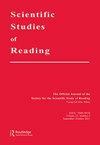从跨语言角度看单词的读写
IF 2.4
2区 教育学
Q1 EDUCATION & EDUCATIONAL RESEARCH
引用次数: 15
摘要
摘要:我们回顾了通过脚本传递意义、声音和拼写信息的认知语言学方法,以强调书面语和口语的可变性对单词读写学习的影响。通过不同文字(包括汉语、阿拉伯语、波斯语和英语等)的单词识别和单词书写示例,我们强调了1)单词的特征和边界,以及这些特征和边界有时如何给阅读和拼写带来挑战;2)语音敏感性,包括印刷品中的语音遗漏、超节段处理,口语和书面形式之间的“距离”,相对于单词水平的识字习得,3)特定类型的发散视觉拼写知识对掌握不同写作系统的重要性,以及4)扩大对视觉运动技能及其在跨脚本拼写中的作用的理解。随着阅读或写作的理论模型和干预方法在不同的写作系统中进行测试,不同写作系统中可变性的所有这些方面都应该得到更广泛的整合。本文章由计算机程序翻译,如有差异,请以英文原文为准。
Reading and Writing Words: A Cross-Linguistic Perspective
ABSTRACT We review cognitive-linguistic approaches to conveying meaning, sound, and orthographic information across scripts in order to highlight the impact of variability in written and spoken language on learning to read and to write words. With examples of word recognition and word writing from different scripts, including Chinese, Arabic, Persian, and English among others, we highlight 1) characteristics and boundaries of a word and how these sometimes present challenges for reading and spelling, 2) phonological sensitivity, including phonological omissions in print, suprasegmental processing, and “distance” between spoken and written forms, vis-à-vis literacy acquisition at the word level, 3) the importance of specific types of divergent visual-orthographic knowledge for the mastery of different writing systems, and 4) expanding understanding of visual-motor skills and their role in spelling across scripts. All of these aspects of variability in different writing systems should be more broadly integrated as theoretical models and intervention methods of reading or writing are tested across different writing systems.
求助全文
通过发布文献求助,成功后即可免费获取论文全文。
去求助
来源期刊

Scientific Studies of Reading
Multiple-
CiteScore
7.20
自引率
2.70%
发文量
26
期刊介绍:
This journal publishes original empirical investigations dealing with all aspects of reading and its related areas, and, occasionally, scholarly reviews of the literature, papers focused on theory development, and discussions of social policy issues. Papers range from very basic studies to those whose main thrust is toward educational practice. The journal also includes work on "all aspects of reading and its related areas," a phrase that is sufficiently general to encompass issues related to word recognition, comprehension, writing, intervention, and assessment involving very young children and/or adults.
 求助内容:
求助内容: 应助结果提醒方式:
应助结果提醒方式:


